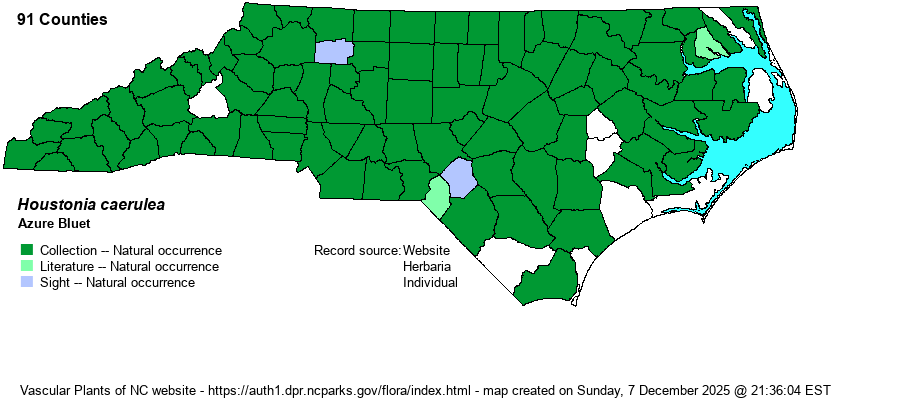| Author | L. | |
| Distribution | Nearly throughout the state, but absent along the immediate coast.
This is a widespread Eastern species, found from eastern Canada south to northern FL and LA. | |
| Abundance | Common to very common across the state; perhaps only frequent to common in the Mountains; scarce near the coast. | |
| Habitat | This is a very familiar species of dry to mesic clay soil, typically where there is little competition -- stream banks, wooded borders, fields, openings in upland woods, powerline clearings, and many other places, including lawns. | |
| Phenology | Blooms from March to May, and fruits from May to June. | |
| Identification | This is a tiny and very slender species, a welcome harbinger of spring, despite its very small size. It grows only to about 4 inches tall, with a cluster of small, rounded basal leaves. There are only one to several tiny pairs of opposite stem leaves, each oblanceolate but barely 1/5-inch long. The top of the stem, or any of the few branches, contains the familiar bluet flower -- 4 spreading light blue petals with a yellow eye. The spread of the flower is about 2/5-inch across. Usually, many will be found blooming in a small area. H. pusilla is somewhat similar, but even smaller, and it has a dark red eye and a more medium blue to lavender blue flower. H. serpyllifolia, a mountain plant, can grow near this species, but it has a creeping stem that sends up flowering stalks, and it has a richer blue flower. | |
| Taxonomic Comments | A few references have this and other Houstonia species in the genus Hedyotis; most do not.
| |
| Other Common Name(s) | Quaker Ladies, Innocence, Common Bluet, Little Bluet, Bluets. The first two are quirky and idiosyncratic. | |
| State Rank | S5 | |
| Global Rank | G5 | |
| State Status | | |
| US Status | | |
| USACE-agcp | FAC link |
| USACE-emp | FACU link |

